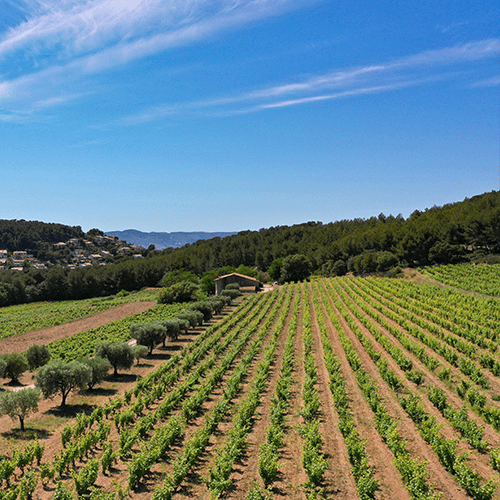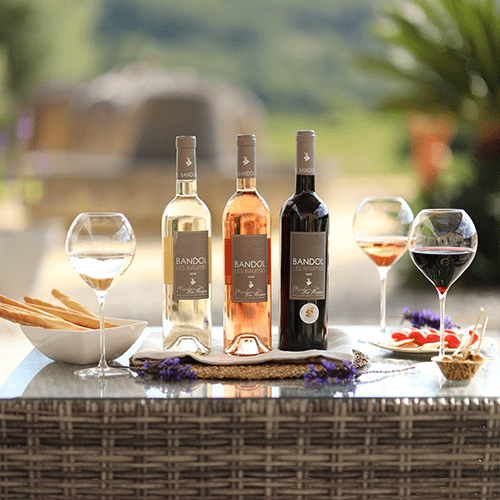
Appellation Bandol
A mosaic of terroirs
Bandol is a vast natural amphitheatre planted with vines, looking out to the Mediterranean sea. It is an encounter between sun, sea, wind, rock and vegetation. Producers here are the go-betweens that help bring the best out of each element.
Our vineyard is protected from northerly air flows by the Sainte-Baume and Mont Caume mountains. The hillsides are bathed in sunshine all year round and are regularly subject to Mistral winds. They also have some of the lowest rainfall in France.


We produce wines originating from plots in the eight villages that form the Bandol appellation area. These different plots with their poor, dry soils, where the geology is primarily characterized by marl and limestone, give the appellation its diversity and can be broken down into five key rock and soil types:
- Les Sables Rouges (red sands) are soils with a high iron oxide content and dotted with limestone pebbles.
- Les Marnes Noires (black marl) are our hardest soils where the vines have to work twice as hard to develop roots.
- Les Calcaires à Rudistes: The vines here dig for their resources in the limestone bedrock formed by the remains of marine creatures of the Jurassic and Cretaceous periods.
- Les Galets du Trias: This most southerly of the five terroirs has a clay and limestone subsoil and is dotted with stones which retain heat during the day and radiate it at night.
- Les Marnes Sableuses (sandy marl) are like a garden where the vines grow naturally. The subsoil here forces the vines to develop an extensive root system.
The vineyard is formed of terraces known locally as “restanques”. A series of dry-stone walls shape the hillside into cultivatable surfaces and prevent erosion. Restanques also play a role in regulating water resources and preserve the natural habitats of local biodiversity.
Another essential aspect of the Bandol appellation is the presence of the sea just a few kilometres away.
It has a heat-regulating effect which is particularly important in summer, with the sea breeze cooling the vineyards on very hot days.

Bandol red, rosé and white
Historically known for the growing of red wines, the Bandol wine region has more recently become a specialist in the production of rosé. Our red wines are made with a majority of Mourvèdre blended with Cinsault, Carignan, Syrah or Grenache.
Our white Bandol wines, which are lesser known than the reds – accounting for 5% of the AOC’s production – are made with the appellation’s traditional white varieties: Clairette, Ugni Blanc and Bourboulenc. These are pleasurable aromatic wines which always have beautiful freshness thanks to the terroir, geology and our microclimate.


Mourvèdre – Principal variety of Bandol
The old Provençal saying “Mourvèdre must see the sea…” makes perfect sense when it comes to the terroir of Bandol.
Originating from Spain where it is commonly known as Monastrell, or Matarò in Catalonia, this grape thrives in the sunny climate of the Bandol appellation. The hot, dry days tempered by sea breezes and cooler night-time conditions suit it particularly well. Its vines are elegant-looking and it develops long roots during periods of hydric stress, allowing it to seek water and mineral elements deep in the ground. Its robustness enables it to survive the windy weather that our plots see throughout the year.
In the Bandol wine region, Mourvèdre produces red wines that are intense, powerful and classically elegant, bursting with sun, spices and fruit. And although powerful, these are wines that conserve real freshness and superb finesse. All of our red wines are made predominantly with Mourvèdre that we blend with Cinsault and/or Carignan – Cinsault for its light, fruity character and low alcohol to balance the powerfulness of Mourvèdre and, on the other end of the spectrum, Carignan to support this intensity and depth of colour while bringing tannin and acidity.
Our Bandol rosés are also made from Mourvèdre with a blend of Grenache and Cinsault. These aromatic rosé wines boast spiciness, fruitiness and good body, balanced by a fine and elegant structure.



